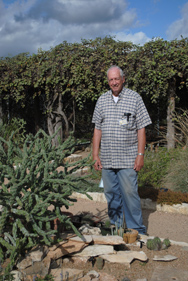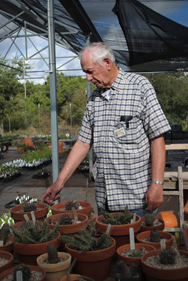Nuclear Energy
WHAT HAPPENS WHEN A RETIRED Army Lieutenant Colonel with ordnance experience in the Cold War, Korea and Vietnam volunteers at the Lady Bird Johnson Wildflower Center?
A whole lot!

“Tall Paul” Reinartz stands over his cactus garden.
Since Paul Reinartz, called “Tall Paul” as befits someone who stands 6’7″, started volunteering 17 years 8 months ago at the National Wildflower Research Center, a good many things have gotten done.
- The pole barn has been organized down to separating nuts and bolts by size, cleaning and restoring them to the 80 bins where they are stored.
- Pruners, loppers and other tools have been sharpened, repaired and cleaned.
- Garden carts have been overhauled.
- Broken benches have been fixed and put back in service.
- Vines—Reinartz calls them the “grapes of wrath”—have been trimmed and arbors repaired—Tall Paul doesn’t need a ladder
- Labor saving devices, like the water cutoff and hose rest in the planting area, have been constructed.
- The volunteer room has new shelves.
“I’m a nuclear weapons guy. My background is tidiness and punctuality,” he said. “By training I see what needs fixing and I fix it.”
Reinartz, who with 5,827 volunteer hours accrued leads the Center’s 700 volunteers in hours served, was honored at this year’s Volunteer Award Dinner. Volunteer work is valued at $21.91 an hour, meaning that Reinartz’ service would equal $127,669.57.
Despite his impressive service resume, it wasn’t until this year that Reinartz actually designed and built his own garden, the new, exquisitely- detailed cactus garden in the front section of the Theme Gardens.
Already a skilled propagator of cactus, he still demurred when senior horticulturist Julie Marcus asked him to work on a garden left disrupted when an art display was reclaimed. “I’m not a landscaper,” he said. Seeing the result, one would argue.
“We’ve all been very impressed with the design,” said Andrea DeLong-Amaya, director of horticulture. “There is quite a bit of complexity in the small space, with carefully chosen rocks, thoughtful placement and nooks and crannies here and there to feature some of the smaller cacti. As a long-time gardener and member of the Wildflower Center’s volunteer crew since we opened at this location, Paul is very knowledgeable and has been working closely with our nursery manager, Sean, in growing a multitude of cacti species from seed and nurturing them into full grown plants.”

Tall Paul inspects some mother cacti in the propagation facility backstage at the Wildflower Center.
As an ordnance officer, Reinartz planned for all the necessities—and did the same when he considered the drainage, maintenance, safety and aesthetic needs of the cactus garden. He built up the site to provide elevation for some of the plants. He imported rocks of all descriptions, locating them on the property and moving them to his garden and identifying those with eye appeal. Chert, the flint used to make Native American arrowheads, graces all the pots. Rock perforated by rainwater provides planting areas for tiny cacti. Rocks form a drainage sinkhole. Rocks imitate the dikes found in West Texas where ancient lava forced its way through the ground. A big flat stone creates a shelter for Spike, a Texas spiny lizard who hangs out in the garden.
Some rocks have names… “Whistler” has a face like a person whistling. “Diamond in the Rough” has crystals. “Coconut” has eyes.
The Wildflower Center is not the only Austin institution to benefit from Reinartz’ extraordinary dedication. When he retired from the Army after tours in Germany, Korea, Vietnam, France, Texas and New Jersey, he moved to Austin and was able to indulge his love of gardening for the first time. He became active in the Men’s Garden Club, serving twice as president, as well as the Organic Gardening Club, the Bromeliad Society and the Chrysanthemum Society. He volunteered at the Governors’ Mansion, designing and maintaining the vegetable garden at the Governors’ Mansion, working under four Texas governors.
At the Wildflower Center, he is on site almost every day. “And he makes good coffee,” said DeLong-Amaya.
Written by Saralee Tiede

